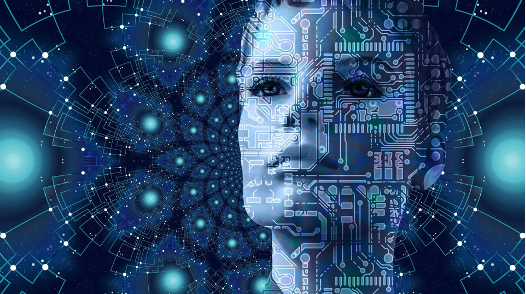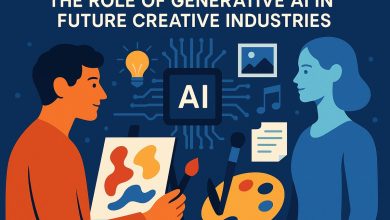
Artificial intelligence and its applications are not novel developments. They have been in existence for several decades. However, with the advent of Generative AI (genAI), such as ChatGPT, Google Gemini, Microsoft Co-pilot and Claude, among others, the business world has chartered into a revolutionary path of a hyper-realistic level of natural language processing, far beyond rule-based AI systems.
Given that ChatGPT or other GenAIs are content-based tools, they have significant applications in L&D and training development areas. The large-scale training program development and delivery in entrprise learning can be time-consuming. That’s where GenAI tools have the highest potential to act as massive time-savers for course designers and educators. GenAI tools can efficiently and quickly create the structure and content for a course, as well as assessments and quizzes. Thus, extending GenAI to create various L&D deliverables can significantly reduce human effort and cost and accelerate the overall training program design process.
Typically, enterprise training program development and delivery involves 9 steps, described below, which can be optimized and accelerated significantly by leveraging the combination of GenAI tools:
Analyzing Training Gaps and Needs
The first step in enterprise training development is assessing the training gaps and needs. Typically, training specialists look at skills required for a particular job and then review performance data to identify gaps in the current training structure and content. Based on this analysis, they determine certain performance or skill gaps and new training needs. Generally, this leads to determining skills or competencies that must be taught in a new or revised training program.
This assessment is usually done manually through back-and-forth conversations with experts by making qualitative references from various sources or inputs. The accuracy of this process is as good as that of the people involved in conducting the gap analysis, besides being highly effort-intensive and subjective.
This is where ChatGPT or equivalent GenAI tools become useful in L&D as they can perform the analysis objectively and within a few minutes. The tools like ChatDoc AI, Pop AI, Mind Grasp AI, DocLime AI, or Humata AI can analyze a given set of documents, such as presentation slides, vendor documents, procedures, field data, student performance data, student feedback, reviewer comments, and other sources.
Based on that, GenAI can identify patterns of skill or performance gaps against the specified learning goals. It can further recommend what additional content should be developed to deliver the identified skills. When automated, such a process can reduce a massive amount of human time.
Creating a Training Outline and Structure
The next step in training development is creating a course outline, modular structure, and module outline. Typically, this process involves thoroughly reviewing relevant and available documentation (which may include formal standard operating procedures), field notes, and training gap analysis with stakeholders and consulting them. Like other training development processes, this also requires human intervention and multiple discussions, reviews, and approvals from stakeholders.
However, GenAI can be utilized here to perform that task by leveraging available documentation to create a training course that includes hands-on activities, case examples, quizzes, and assessments. Within seconds, the GenAI tools can create a high-level module and sub-bullets for the course, including topics and sub-topics. It is up to the designers to decide the level of detail they want in the course outline. The users can also quickly create a day-by-day or topic-by-topic agenda or lesson plan.
While the AI’s output may need to be revised by a human, the speed with which it creates this intelligence is impressive and could potentially be used to expedite the course creation process. The generated outline can then be refined further by the instructional designers.
Developing Instructor’s Presentation Slides
As a standard practice, the next logical step is to develop instructor-driven presentation slides, whether in-person or remote training classes, as the primary delivery mechanism. Presentation slides are facilitation tools that can be used to create storyboards for instructor-led videos. Even if a course is self-learning-based, presentation slides are prepared in some form, whether as a script or a storyboard.
You can feed the outline developed in the previous step to ChatGPT or equivalent GenAI tools and prompt it to create the outline of slides as the output. The tools can generate a well-organized and logical skeleton for the presentation outline that can act as an accelerated headstart for instructional designers to populate and correct the content depending on the program’s needs.
This outline can be used as input to tools like Gamma AI or Tome AI, which can convert it into full-blown, text- and image-rich presentations at lightning speed. These tools can automatically select appropriate images for the content and context and provide the slides in the most suitable layout to support the goal. In most cases, the output slides provide enough structure to make it easier for instructors to populate relevant information or even force it to use contextual images from a specific repository. Thus, GenAI tools can help eliminate manual work and swiftly create a draft representation of the presentation slides.
Creating Problem-Solving Case Scenarios
Most jobs now require higher-order problem-solving, technical, troubleshooting, and decision-making skills. Thus, most enterprise training programs require designing scenario-based, thinking-intensive content that allows learners to practice on certain expectations. Typically, scenarios are designed based on field events or canned scenarios provided by SMEs. It is a manual process conducted by instructional designers and subject matter experts, which can be quite time-consuming.
However, GenAI tools can help us streamline the effort required and expedite the course development process. You can prompt GenAI tool to focus on critical aspects of a challenge and create a story-based case study for students to solve. ChatGPT and equivalent tools can generate a detailed story-based self-contained case study with necessary variables like situation, problem, constraints, and questions to test learners’ deeper understanding and help them troubleshoot common scenarios. GenAI can create well-structured case study assignments if relevant materials or additional data from repositories are provided.
Create Learners’ Assessments and Assignments
Most enterprise training courses include assessments, quizzes, or exams during and at the end of the training modules. Depending on the job, the nature of the assessment varies. The assessment can be in various formats, such as multiple choice, short answer, or essay type. Here, you can leverage the power of GenAI tools to build systematic and highly targeted assessments for the training program. For instance, you can specify the duration of the course and prompt GenAI tools to create an appropriate take-home assignment as well as course-end assessments that include a list of appropriate questions or assignments aligned with the scope of the course and level.
With appropriate prompts and scoping instructions, GenAI tools can be customized to provide more challenging assignments. Thus, GenAI tools can be used to accelerate the process of creating student assignments and various types of student work and quizzes.
Creating Self-learning Content and Videos
More and more enterprise training now involves a blended learning approach. Training material now relies heavily on self-paced content and videos. However, creating self-paced material, especially videos of good quality, is very time-consuming, requiring a range of logistics from cameras, software, editing tools, and other hardware. With GenAI, this self-learning content can be created with minimal effort and reduced time. For instance, the presentation content generated by Gamma.ai can be imported into Pictory AI, which converts it into a storyboard. This tool automatically sequences all the scenes and video clips contextually. It selects relevant stock footage based on the context and content provided. The enterprise-hosted GenAI tools allow the selection of relevant pictures and footage from corporate repositories selectively, thus producing highly contextual videos. The faceless video thus created can be edited for scripts, scenes, clips, and sequences and can be used as online training material.
An instructor-driven video has great engagement and retention value for enterprise courses. However, it would require a considerable setup of greenscreen, cameras, and post-shooting editing, which is a massive investment in cost and time. For that, you can use D-ID AI tool or Synthesia AI to create a self-learning. These tools allow you to upload an instructor picture and create a near-realistic replica of an instructor to narrate the content as a video without having to shoot a single video.
Once you add an inbuilt voiceover or the one from your instructor, you can produce a ready-to-deploy, self-paced learning video in no time. Such videos provide learners with a personalized learning experience, sparing them from dispassionate robo-lessons. Some AI tools can intelligently read the transcript and segment or even edit the video into multiple short videos, which can be used appropriately for various learning paths.
Deploying GenAI as a Trainer
While some organizations have transitioned to remote learning for training, instructor resources are still required to conduct formal training. Instructor resources are the most expensive resources in any training program. However, GenAI has the potential to leverage it to deliver training as a real trainer in the form of self-learning videos or as chatbot, with which learners can have a human-like conversation. GenAI tools can understand the context and provide information specific to users’ queries or target audiences. GenAI can be pre-programmed to ask sense-making questions to adaptively understand a learner’s grasp of the topic. This use case holds big promises by combining GenAI, chatbot, adaptive learning paths, and self-learning videos.
Using the latest advancements in chatbots, you can engage learners during the learning process in a bidirectional conversation as if each of them has a personalized teacher by their side. Learners can ask questions, clarify, and expand answers in whatever order they feel right to understand them thoroughly. Such engaging and lively conversation ultimately facilitates the learning process.
In addition, real adaptive learning can happen because GenAI tools will progressively determine the learner’s progress and grasp of content and then change the learning path based on the learner’s knowledge acquisition level. For instance, you can prompt ChatGPT to act as a trainer and teach the specified content to a 10-year-old.
Deploying GenAI as an Automated Assessor
Assessment of learners is usually a resource-intensive task, regardless of whether you use auto-grading in LMS against a preset answer key or assign an instructor to provide human grading and qualitative feedback. GenAI can make this assessment efficient, deeper, and comprehensive for the assessment questions and feedback. GenAI, when implemented as a chatbot with a pre-programmed sequence of questions, can be used to deliver training and assess understanding. The tool can grade learners’ understanding of the topic with questions and provide in-depth interactive feedback that accurately pinpoints their areas for improvement. It could even offer targeted lessons to close that gap.
Deploying GenAI as a Support Resource or an Expert Mentor
Training is not a complete solution. Learners also need support in the field, which may come through peer help or expert mentorship. Organizations normally employ performance support systems such as learning portals, communities of practice, and buddy systems. Nevertheless, GenAI has emerged as a great workflow-based performance support system. If you have new learners who have not received advanced training on specific topics, you can implement a chatbot expert that can be programmed to deliver expert feedback or suggestions in the context of the user’s problem. It brings the know-how to the audience’s level. ChatGPT can serve as a helpful buddy or mentor to guide learners on-demand during the workflow.
Final Thought
While most of the steps are invariably used in any standard instructional design project, some of the steps may not be applicable to certain organizations, depending on the nature of the business. However, there is a logical progression of steps to eliminate duplication and minimize efforts in such a way that you could apply the output of the previous step seamlessly into the following step.


